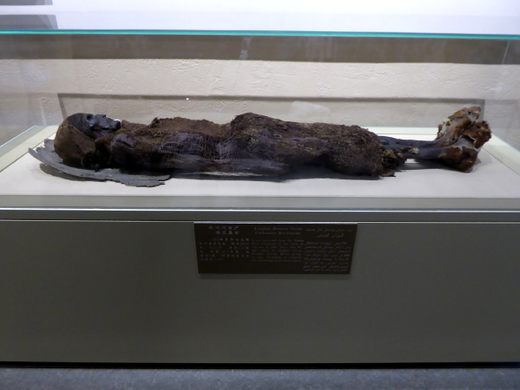Tarim Mummies
These excavated burials from the Tarim Basin are wrapped in mystery.
In northwest China, 1,600 miles from Beijing, the Xinjiang Uygur Autonomous Region Museum in Urumqi safeguards the exceptional remains of several ancient mummies, the oldest of which is nearly 4,000 years old. What makes these stand out from the run-of-the-mill mummies in most museums is that although they were found in an Asian desert, they, mysteriously, have distinctly Caucasian features. One mummy, known as “Cherchen Man,” even sports red hair and a full beard.
First discovered in the early 20th century, it was almost a century before the mummies were rediscovered and fully examined. Nearly 200 graves were found in the region, and although the people who originally dug them have not been identified, their DNA shows they have an Eastern European, Central Asian, and Siberian heritage. According to Tarim Basin expert Professor Victor Mair of the University of Pennsylvania, they likely spoke a Tocharian language similar to those found in Eastern Europe.
The burials themselves have distinctive features including overt and prolific phallic and vulval symbolism. The mummies were covered by inverted boats and buried with a variety of goods including masks, baskets, and medicines. Of particular interest were the well-preserved clothes which, given their skimpiness, Nicholas Wade of the New York Times described as looking like they were supplied by “a Bronze Age salesclerk from Victoria’s Secret.” Elizabeth Wayland Barber, a textile expert who has written extensively about the mummies, suggests that the clothing is very similar to Western European styles, deepening the mystery of their origin.
Perhaps the most famous of the mummies is “The Beauty of Loulan,” who is the oldest at over 3,800 years, and one of the best preserved. It is believed that she lived to be about 40 to 45 years old and died of a lung ailment. Another female, the Hami Mummy, is known as the “red-headed beauty” and is much younger, having lived somewhere between 1,400 and 800 BCE. Also notable are the “Witches of Subeshi,” who sport tall brimmed conical hats.
In recent decades, the mummies have been at the center of a bitter, and often violent political and cultural battle between the Chinese government, dominated by Han Chinese, and the Uighur minority. Because the Uighurs’ heritage is a Caucasian and East Asian blend, they see the DNA of the mummies as a claim of preeminence in the region, although historical records show Uighurs entering the Tarim Basin only in the 10th century. Uighurs have gone so far as to promote pop songs about the mummies to raise awareness and rally support. The Chinese government, however, has asserted that the mummies are of East Asian origin and do not recognize Uighur claims. Currently, Uighur culture is being severely quashed by the government, which reportedly has detained hundreds of thousands of them in re-education camps.
Know Before You Go
Despite being near the Eurasian pole of inaccessibility, Urumqi is much easier to reach today than it has been in the past. With a population over 3.5 million, the city is a hub for China Southern Airlines and daily flights are available from other major carriers as well. The museum is generally open 10 a.m. to 6 p.m., but the hours vary seasonally. It is best to call ahead to check the hours and make sure the mummies are on display.


















Follow us on Twitter to get the latest on the world's hidden wonders.
Like us on Facebook to get the latest on the world's hidden wonders.
Follow us on Twitter Like us on Facebook